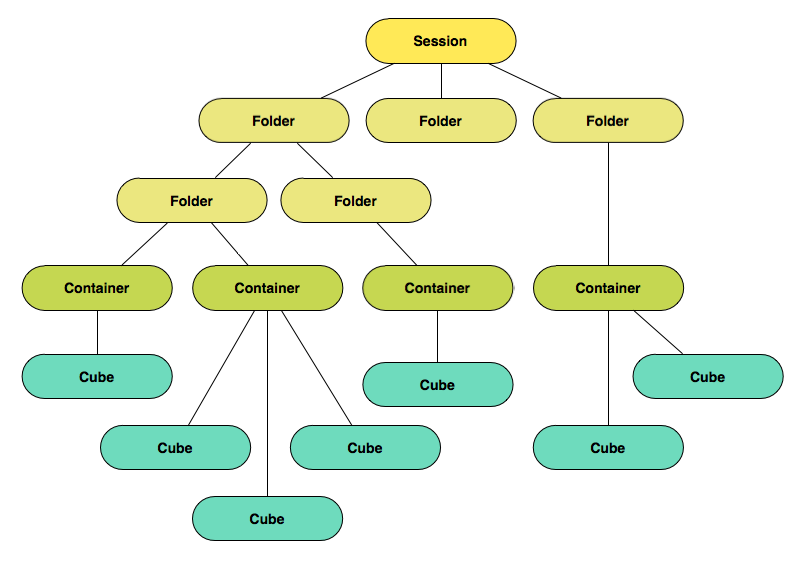Ophidia platorm includes a flexible hierarchical system to store datacubes.
In Ophidia data space consists of a number of separated session spaces (sessions for brevity). A datacube cannot be transfered from a session to another (unless they are exported and then imported), but data of a session can be shared among more users (see Session management).
Within the session space, as shown in next figure, datacubes are organized in directories and sub-directories (called folders in Ophidia) according to classic hierarchical model adopted by most of operating systems.

Note that the objects contained in a directory can be sub-directories or containers. In general, a container represents a group of cubes having the same data grid, but it could contain even just one cube. The concept of container refers to data source, whereas the concept of cube refers to single measure.
This layer of the Ophidia file system has been thought to enable massive operations on datasets with several measures (each of them corresponding to a different cube) but with the same grid. For instance, consider a NetCDF file with more variables having the same grid. In this case a container would correspond to a file whereas a datacube would correspond to each variable of the file.
There exist specific filters for massive operations to select the datacubes belonging to a given container, thus providing a simple way to process all the data stored in a container.
The following Ophidia operators have been designed to handle this file system:
Ophidia Terminal saves the path to current working directory by updating the environmental variable OPH_CWD automatically (see also Ophidia Terminal environment). Of course, this virtual path is related to current working session indicated by OPH_SESSION_ID.
It is worth pointing out that Ophidia file system differs from the actual file system used for import/export operations. The former is virtual and allows the user to browse the datacubes stored within Ophidia platform. The latter, external to Ophidia, is related to the repository of datasets that can be imported/exported in/from the platform.
Virtual file system allows the user to organize containers and cubes within Ophidia platform, whereas browsing the actual file system enables the user to find files to be imported in the platform as well as files that have been exported (see OPH_FS).
Concerning the virtual file system, users are able to create new folders, containers and cubes provided that they are authorized to access the corresponding session. Instead, access to real file system is usually limited to directory exploration and file read/import. In particular, Ophidia Framework can be configured to enable browsing of the content of BASE_SRC_PATH, which represents the root folder of the data repository for import/export operations (see framework configuration notes for further details).
Ophidia Terminal saves the relative path to current data directory by updating the environmental variable OPH_CDD automatically (see also Ophidia Terminal environment). The absolute path to data directory is obtained by concatenating BASE_SRC_PATH and the relative path.
How to print current working directory?
pwd
How to list the contain of current working directory?
ls
How to list the cubes stored in current working directory?
ll
How to list the contain of the directory?
ls /path/to/directory
How to create a new container name with dimensions latitude (lat), longitude (lon) and time?
cc name
How to remove an empty container name?
rm name
How to create a new directory name?
mkdir name
How to change current working directory to name?
cd name
How to remove an empty directory name?
rmdir name
How to print current data directory?
pdd
How to list the contain of current data directory?
lsd
How to change current data directory to name?
cdd name